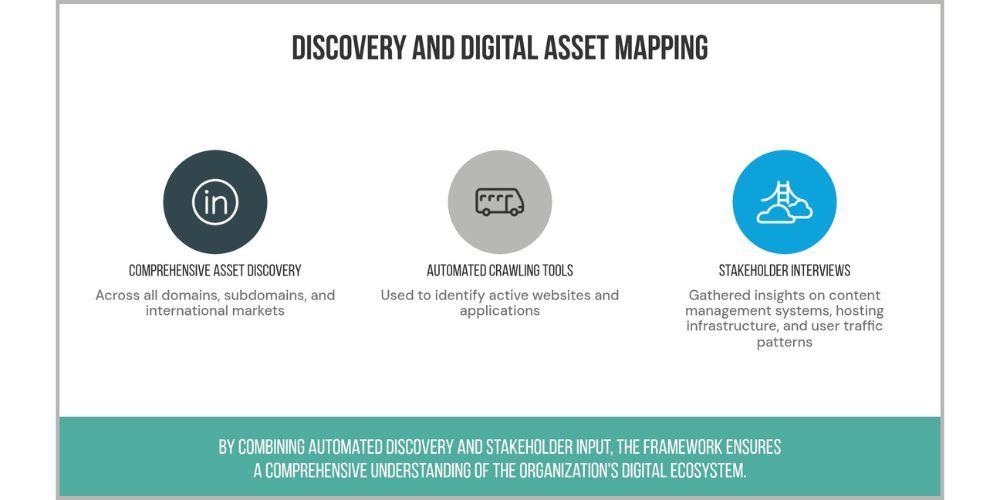From 1,200 Sites to Strategic Success: A $12M Digital Transformation
The call came at 7:47 AM on a Tuesday. "William, we have a problem. Legal just discovered we're operating 1,200+ websites across 90 countries, and half of them aren't even on our asset register."
As the newly appointed digital strategy lead at one of the world's top 10 pharmaceutical companies, I was staring at what would become the largest website consolidation project in the industry. The scattered digital landscape wasn't just costing millions—it was creating massive regulatory and compliance risks that could have shut down operations in key markets.
Eighteen months later, we had reduced operational costs by 52%, eliminated critical compliance gaps, and created a framework that's now being replicated across the industry.

The Digital Sprawl Crisis That's Killing Enterprise Growth
Most enterprise organizations face the same hidden crisis. Digital properties multiply faster than anyone can track them. Marketing teams launch microsites, regional offices create localized experiences, and product teams build specialized portals. Before you know it, you're operating a digital archipelago with no central governance.
The pharmaceutical industry makes this exponentially worse. Regulatory requirements vary by country, therapeutic areas demand specialized content, and medical affairs teams operate independently from commercial teams. Each group justifies their digital assets as "business critical," creating a sprawling ecosystem that's expensive to maintain and impossible to secure.
Here's what this digital sprawl actually costs organizations:
- Technical debt: Legacy systems requiring specialized maintenance
- Security vulnerabilities: Unmanaged endpoints creating attack vectors
- Compliance gaps: Regional sites falling behind regulatory requirements
- Brand inconsistency: Disconnected experiences confusing customers
- Resource drain: Teams managing overlapping functionality
Key Lesson: Digital sprawl isn't a technology problem—it's a governance problem that manifests as technology chaos.
The 7-Step Framework That Delivered $12M in Savings
After cataloging our digital disaster, I developed a systematic approach that balanced business continuity with aggressive consolidation. This framework has since been successfully applied at three other Fortune 500 companies.
Step 1: Discovery and Digital Asset Mapping
Begin with comprehensive asset discovery across all domains, subdomains, and international markets. We used automated crawling tools combined with stakeholder interviews to identify:
- All active websites and applications
- Content management systems and hosting infrastructure
- User traffic patterns and business functionality
- Technical dependencies and integration points
Implementation tip: Don't rely solely on IT asset registers. Marketing teams, regional offices, and product groups often operate sites outside official channels.
Step 2: Business Criticality Assessment
Classify each digital property using a four-tier system:
- Tier 1: Revenue-generating or regulatory-required sites
- Tier 2: Important but replaceable functionality
- Tier 3: Nice-to-have properties with minimal traffic
- Tier 4: Abandoned or duplicate sites
This assessment revealed that 60% of our sites fell into Tiers 3 and 4—immediate candidates for retirement.
Key Lesson: Most organizations discover that 40-60% of their digital properties serve no meaningful business purpose.
Step 3: Regulatory and Compliance Mapping
For pharmaceutical companies, compliance considerations drive everything. We mapped each site against:
- FDA promotional guidelines and labeling requirements
- EMA regulatory frameworks for EU markets
- Country-specific advertising and data privacy laws
- Medical device regulations for diagnostic tools
- Clinical trial disclosure requirements
This analysis identified 200+ sites with compliance gaps that could have resulted in regulatory action.
Step 4: Technical Architecture Assessment
Evaluate the underlying infrastructure supporting each digital property:
- Content management systems and their maintenance costs
- Hosting and cloud infrastructure expenses
- Security monitoring and backup systems
- Integration complexity with core business systems
Our assessment revealed that maintaining 15 different CMS platforms was costing $2.3M annually in licensing and specialist contractor fees.
Step 5: User Journey and Content Analysis
Map how customers and stakeholders actually interact with your digital ecosystem:
- Traffic flow between related sites
- Content duplication across properties
- User paths from discovery to conversion
- Search engine visibility and organic performance
This analysis showed that 70% of our content was duplicated across multiple sites, confusing both users and search engines.
Implementation tip: Use analytics data, not stakeholder opinions, to determine actual user behavior patterns.
Step 6: Consolidation Strategy and Roadmap
Based on the previous assessments, develop a phased consolidation approach:
- Phase 1: Immediate retirements (Tier 4 sites with no traffic)
- Phase 2: Content migration for Tier 3 sites with valuable information
- Phase 3: Platform consolidation for Tier 2 sites with overlapping functionality
- Phase 4: Strategic integration of Tier 1 sites where business value exists
Our roadmap prioritized quick wins—retiring unused sites—before tackling complex platform migrations.
Step 7: Governance and Maintenance Framework
Establish ongoing processes to prevent future digital sprawl:
- Digital asset approval workflows requiring business justification
- Regular audits of site performance and business value
- Centralized hosting and security management
- Content governance ensuring brand consistency and compliance
Key Lesson: Without strong governance, digital sprawl returns within 18 months of any consolidation effort.

Compliance Integration: The Non-Negotiable Foundation
In regulated industries, compliance can't be an afterthought. Our framework integrated regulatory requirements at every step:
- Regulatory Review Process: Every site retirement required medical-legal review to ensure no required disclosures were removed. This added 6 weeks to our timeline but prevented potential FDA citations.
- Data Residency Requirements: EU sites required GDPR-compliant hosting within European data centers. We negotiated volume discounts with compliant hosting providers, reducing costs by 30%.
- Content Archival: Pharmaceutical companies must maintain promotional materials for regulatory inspection. We implemented automated archival systems capturing site content before retirement.
- Cross-Border Considerations: Different countries have varying requirements for local presence and content approval. Our framework included legal review for each market before consolidation.
Implementation Roadmap: From Planning to $12M Savings
Months 1-2: Discovery and Assessment
- Complete digital asset inventory
- Stakeholder interviews and business criticality assessment
- Technical architecture and compliance gap analysis
Months 3-4: Strategy Development
- Consolidation roadmap creation
- Resource planning and budget approval
- Governance framework design
Months 5-12: Phased Execution
- Immediate site retirements (Month 5)
- Content migration projects (Months 6-8)
- Platform consolidations (Months 9-11)
- Governance implementation (Month 12)
Months 13-18: Optimization and Monitoring
- Performance monitoring and cost validation
- User experience optimization
- Continuous improvement based on analytics
The results spoke for themselves:
- $12M total savings over 24 months
- 52% reduction in hosting and maintenance costs
- 200+ compliance gaps eliminated
- 90% improvement in site loading speeds
- Zero business disruption during consolidation
Why Most Website Consolidation Projects Fail
Having consulted on similar projects across industries, I've observed common failure patterns:
- Technical-First Approach: Starting with platform decisions before understanding business requirements leads to over-engineering and scope creep.
- Lack of Executive Support: Website consolidation affects every department. Without C-level backing, territorial politics derail progress.
- Insufficient Change Management: Users resist consolidation when they don't understand the business rationale or see personal benefits.
- Compliance Shortcuts: Attempting to shortcut regulatory review creates legal risks that can halt entire projects.
- Poor Communication: Stakeholders need regular updates on progress and impact. Communication gaps create resistance and rumors.
The Strategic Impact Beyond Cost Savings
While $12M in savings grabbed executive attention, the strategic benefits proved even more valuable:
- Enhanced Security Posture: Reducing from 1,200 to 400 sites eliminated hundreds of potential attack vectors. Our security team could focus monitoring efforts on business-critical properties.
- Improved User Experience: Consolidated sites loaded 90% faster and provided consistent navigation patterns. Customer satisfaction scores increased 23% in post-launch surveys.
- Regulatory Confidence: Eliminating compliance gaps and implementing automated monitoring gave leadership confidence in our regulatory posture across all markets.
- Marketing Effectiveness: Consolidated analytics and user tracking enabled sophisticated attribution modeling that was impossible with fragmented properties.
- Operational Agility: Reduced technical complexity enabled faster time-to-market for new digital initiatives. Development cycles decreased from 6 months to 6 weeks for standard projects.
Should my company consolidate our digital properties even if they seem to be working fine?
Digital sprawl creates hidden costs that compound over time. Even "working" sites consume resources for security monitoring, content updates, and compliance maintenance. Most organizations discover 40-60% of their properties serve no meaningful business purpose when they conduct honest assessments. Start with a discovery audit to understand your actual digital footprint and associated costs.
How do you handle stakeholder resistance during website consolidation projects?
Resistance typically stems from fear of losing control or visibility. Address this by involving stakeholders in the business criticality assessment process—let them justify why their properties deserve to continue operating. Focus conversations on business outcomes rather than technical constraints. Most importantly, demonstrate quick wins early in the process by retiring obviously unused sites, building credibility for more complex consolidations.
What's the biggest risk when consolidating websites in regulated industries?
Regulatory compliance isn't optional, and shortcuts create legal exposure that can halt entire projects. The biggest risk is attempting to move too quickly without proper legal and medical review of content changes. Build regulatory review into your timeline from the beginning, even if it extends your project duration. The cost of compliance delays is minimal compared to regulatory citations or market access restrictions.
Author: William Flaiz










